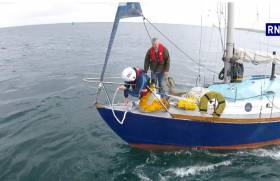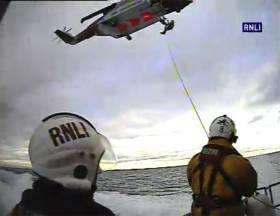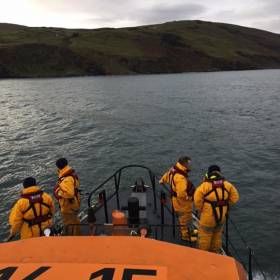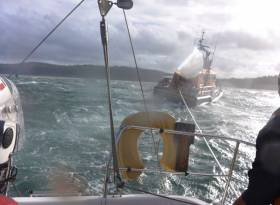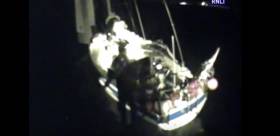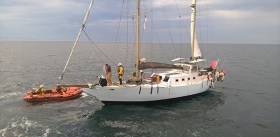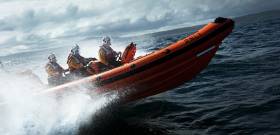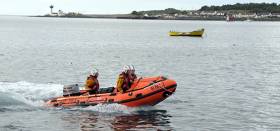Displaying items by tag: Larne
Larne RNLI launched their all-weather lifeboat Dr John McSparron and inshore lifeboat Terry this afternoon (Sunday 11 June) to a 36ft yacht experiencing engine difficulties near the entrance to Larne Lough.
The all-weather lifeboat under Coxswain Frank Healy launched at 1.15pm and made its way to the scene north of the Port of Larne’s number one buoy. On arrival, a volunteer lifeboat crew member transferred onto the yacht where he first checked that the three on board were safe and well. The gear box onboard the yacht was broken and weather conditions presenting a force 3-4 southerly wind meant the crew of the vessel were unable to sail safely back to their mooring in Larne Lough.
The lifeboat crew established a towline before the lifeboat brought the yacht into the safety of Larne harbour. The all-weather lifeboat was met by the station’s inshore lifeboat which assisted to place the boat safely on the mooring.
Speaking following the call out, Larne RNLI Coxswain Frank Healy said: ‘All the crew training was put into action today to carry out a safe and efficient rescue. An excellent team effort ensured that the tow line was set up speedily and the yacht with two adults and a child onboard was safely on its mooring without delay.’
Larne Lifeboat Crew Train Alongside Prestwick Coastguard Helicopter
#RNLI - Larne RNLI launched their all-weather lifeboat Dr John McSparron and inshore lifeboat Terry on Sunday (29 January) to take part in the exercise to simulate recovery of a casualty to a helicopter in an emergency situation.
The joint exercise with the Prestwick Coastguard helicopter Rescue 999 took place one mile north of Larne in Co Antrim.
The lifeboats practiced manoeuvres at speed with the helicopter. A high-line was passed to the all-weather lifeboat, where the winchman landed. Several RNLI crew members were then winched into the helicopter and back onto the deck of the lifeboat.
The RNLI regularly carries out exercises with other rescue agencies, training that ensures rescue crews are able to work together effectively in an emergency situation, including medical evacuation of a casualty to a helicopter.
Larne RNLI second coxswain Norman Surplus said: “We had a very valuable training session with both our lifeboats working under the helicopter in turn. During the joint RNLI–Coastguard exercise all our volunteer crew members reinforced their overall skills knowledge and their hands-on experience of specialised Helicopter operations.
“Close and effective collaboration during such RNLI–Coastguard joint training allows the combined emergency services to be much better prepared to handle real search and rescue situations as and when they arise.”
Larne RNLI extended their thanks to Prestwick Coastguard in Western Scotland for the opportunity to carry out the joint exercise.
Red Bay Lifeboat Joins Search For Missing Person
#RNLI - Volunteers from Red Bay RNLI in Co Antrim joined in the ongoing search for a missing woman yesterday (Sunday 18 December).
The all-weather lifeboat, under coxswain Paddy McLaughlin and with six crew members onboard, launched at 11.30am and continued searching until 6pm yeserday evening.
The lifeboat started its search in the area of Ballintoy before moving south to Torr Head. Coastguard units meanwhile searched the shoreline.
Weather conditions were favourable with a cold but moderate sea and good visibility.
“We searched in good conditions for most of today but unfortunately we didn’t find anything,” said McLaughlin.
“Our thoughts remain with the lady’s family during an ongoing search.”
Elsewhere, the volunteer lifeboat crew at Larne RNLI responded to a launch request from the UK Coastguard yesterday morning.
The initial alarm was raised by a concerned member of the public who reported seeing a person signalling to shore from a fishing vessel around 1.5 nautical miles off Glenarm.
Larne RNLI’s all-weather lifeboat launched at 10.45am and quickly made its way to Glenarm. The lifeboat crew made radio contact with a fishing vessel in the area who confirmed they did not require any assistance.
The surrounding area was searched to ensure there were no other vessels nearby. The lifeboat was returned to Larne after it was established as a false alarm with good intent.
Speaking following the callout, Larne RNLI coxswain Frank Healy said: “We thank this vigilant member of the public who called the coastguard out of genuine concern.
“We would urge anyone who is concerned that someone is in distress along our coast to always ring 999 and ask for the coastguard. We would always rather launch to a false alarm with good intent than not launch at all.”
Larne RNLI will host its annual icebreaker swim at 12 noon on New Year’s Eve at Ballygally Beach.
The lifeboat station is asking people to 'Get freezin' for a reason' this New Year’s Eve, with all money raised going to the RNLI to help save lives at sea.
Anyone interested in taking part can obtain a sponsor form by contacting 07516 496945 or the station’s Facebook page, or collect on the day.
Hot refreshments will be available at the Ballygally community centre following the swim.
Larne Lifeboat Station To Open Its Doors For Macmillan Coffee Morning
#RNLI - Larne RNLI's volunteer crew are throwing open the doors of their lifeboat station this coming Friday 30 September as they host a coffee morning to raise funds for Macmillan, the cancer support charity.
Doors open at 10am at 11 Olderfleet Road and the crew are already planning a 'bake off' to entice the public along and to dig deep for the charity.
The main organiser of the fundraiser is Larne RNLI lifeboat mechanic Derek Rea, who lost his uncle to cancer when he was younger and has had some close friends battle the illness.
It is a cause that is close to the heart of the entire station. Second coxswain Norman Surplus recently had his own battle with the disease and raised funds for cancer charities when he flew his gyrocopter round the world last year.
Commenting on the fundraising event, Rea said: "This will be a fundraiser with a difference for us here. As a charity we are thankful to the people of Larne for supporting the lifeboat but we also want to help others and raise funds for this worthy cause.
"There is hardly a person whose life has not been touched by cancer, either through battling it themselves or seeing someone they care about suffering with it. Support for cancer sufferers and research into treatment is ongoing and the Macmillan coffee morning is a great way to raise awareness and funds for this work."
Learn more about the Macmillan coffee morning fundraisers HERE.
Three Callouts In A Weekend For Larne Lifeboat Crew
#RNLI - Larne RNLI launched last Friday 9 and Sunday 1 September to help recover a total of three yachts that had broken from moorings in severe weather.
The inshore lifeboat launched at 4.05pm on Friday to reports of a 29ft yacht broken free of its mooring in the shipping channel.
Due to the severe weather, with Force 8 winds, the Larne all-weather lifeboat under coxswain Frank Healy launched at 4.25pm and made its way to the scene near Curran Quay.
Two crew members boarded the yacht to set up a tow. The conditions were particularly challenging with a broken mast, loose rigging and a very heavy sea, but the yacht was secured safely to a mooring in Larne Lough.
On Sunday, the volunteer RNLI crew completed weekly training by midday but were paged only a matter of hours later to launch after reports of two yachts encroaching on the shipping channel.
As winds were gusting up to Force 10, it was decided to launch the all-weather lifeboat to attend the yachts, one of which had broken from its mooring while the other was dragging its mooring into the shipping channel.
Lifeboat crew were placed aboard the first yacht and a tow established, it was then secured to another mooring. Once the first yacht was secure, the RNLI crew and the yacht’s owner were placed abroad the yacht dragging its mooring.
Due to the wind and sea conditions in the lough, the decision was made to head for safe harbour in Glenarm rather than attempt a mooring pickup.
Once the casualty vessel was safely on its way to Glenarm under its own steam, Larne lifeboat returned to the station.
Speaking following the callouts, Larne RNLI deputy launching authority Philip Ford-Hutchinson said: "The strong southerly winds and heavy sea state within the lough made these three incidents extremely challenging for our volunteer crews to deal with.
"All their training was called upon in removing the vessels from further danger."
Larne RNLI Rescues Three Yachtswomen After Yacht Gets into Difficulty off Antrim coast
Larne RNLI rescued three people late last night (Friday 29 July) after their 6m yacht got into difficulty off the Antrim coast.
The three women were on passage from Norway to the Caribbean having come through the Caledonian canal, and were heading to Belfast when they encountered problems.
The crew raised the alarm at approximately 11.30pm when their yacht was becalmed having sustained engine failure seven miles north east of Larne.
The all-weather lifeboat under Coxswain Norman Surplus launched at 11.45pm and made its way to the scene near the Highland perch, an area far from the coastline known to be hazardous for its shallow water.
Weather conditions at the time were described as excellent with light to no wind blowing and good visibility despite it being dark.
On arrival, a volunteer lifeboat crew member transferred onto the yacht where he first checked that the three on board were safe and well.
The lifeboat crew then proceeded to work with the vessel’s crew to establish a towline before the lifeboat brought the yacht into the safety of Larne harbour. On arrival the all-weather lifeboat was met by the station’s inshore lifeboat which assisted at the end of the call out to put the boat on the mooring.
Speaking following the call out, Larne RNLI Coxswain Norman Surplus said: ‘The three women did the right thing tonight and raised the alarm when they got into difficulty and thankfully all three are safe and well and we would like to wish them a safe onward journey.
‘We would encourage anyone visiting the coast this summer, to remember to respect the water. When sailing, always have a means for calling and signalling for help and ensure everyone onboard knows how to use it. Always check the weather forecast and tide times. Make sure someone ashore knows where you are going and who to call if you don’t return on time. Learn how to start, run and maintain your engine and always carry tools and spares.’
Larne RNLI came to the aid of four people yesterday evening after their 16m yacht got into difficulty off the County Antrim coast.
At approximately 6.30pm yesterday (Thursday 7 July), the volunteer crew was requested by Belfast Coastguard to launch both their all-weather and inshore lifeboats after it was reported that a large yacht had sustained engine failure a mile north east of Muck Island.
Weather conditions at the time were described as good with a Force 3 wind and a slight swell running.
Arriving on scene, the lifeboat crew observed that one of the four people onboard was suffering from sea sickness.
Crew members from the inshore lifeboat went aboard to provide casualty care to the seasick individual while the all-weather lifeboat crew started to prepare the yacht for towing.
Once a towline was established, the all-weather lifeboat began the passage to Carrick Marina. Due to the large size of the vessel, Larne RNLI’s inshore lifeboat was used to assist with manoeuvring the yacht in the confines of the marina.
Speaking following the call out, Philip Ford-Hutchinson, Larne RNLI Deputy Launching Authority said: ‘This call out was a great example of both our inshore and all-weather lifeboats working well together to assist the four people onboard the casualty vessel. The inshore lifeboat crew members were able to administer casualty care to the person who was seasick before assisting the all-weather crew with setting up a tow and then helping to manoeuvre the yacht in the tight confines of Carrick Marina. Our volunteer crew regularly train for scenarios like this and those skills and training were put to good use last night.’
Local Community Raises Vital Funds For Larne RNLI
#RNLI - Over the last few months the generous people of Larne have raised over £2,000 for their local lifeboat station.
More than £600 was raised by the Great Northern Retro car rally that left Larne at 9am on Saturday 30 April, travelling up the scenic Antrim Coast to Malin Head. The event was very well supported with vehicles of all makes and models.
Meanwhile, local man John Stirling – father of lifeboat crew member Lee Stirling – celebrated his 60th birthday recently with a donation of £300 to the Larne lifeboat.
The Stirling family organised a surprise party and kindly asked for donations to Larne RNLI and the NI Air Ambulance in lieu of gifts.
Additionally, Larne Grammar School year 8 pupils, who are committed supporters of Larne RNLI, have again this year presented their local lifeboat station with a cheque for £1147.89 raised throughout the academic year.
"The people of Larne are very generous and dedicated supporters of our local lifeboat crew," said Jim Kerr, Larne RNLI fundraising chair, :I attended the start of the car rally and it was a fantastic spectacle to see the camper vans and cars leave Larne.
"I’d like to thank Gavin Gray who organised the NI Retros car rally, John Stirling for his birthday donation and the year 8 pupils of Larne grammar school for their kind donations.
"RNLI volunteer lifeboat crews around Ireland are willing to drop everything to go and save lives at sea when their pagers beep. We rely on the generosity of the public to continue our lifesaving service, which we operate day and night, 365 days a year.
"These donations can help fund crew training, contribute towards the running costs of a lifeboat station or buy new crew kit and are greatly appreciated by all at Larne RNLI."
Five RNLI Lifeboats Involved in Search for Missing Microlight Aircraft off Northern Ireland Coast
Five RNLI lifeboats were launched last night from Larne and Red Bay in Northern Ireland and Portpatrick in Scotland to take part in an extensive search for a missing microlight aircraft. The craft is understood to have two people onboard when it was reported missing off the Northern Ireland coastline.
The launch was requested by the coastguard when the aircraft was reported overdue at 8.30pm and a major search operation was put in place.
Joining the five RNLI lifeboats in the major search were the Irish Coast Guard Helicopter Rescue 116 along with a rescue helicopter from Prestwick and local coastguard teams.
Search conditions were described as extremely challenging as visibility was poor due to thick fog. Larne RNLI launched their all-weather lifeboat and D class lifeboat, Red Bay RNLI launched their Atlantic 85 and all-weather lifeboat along with the all-weather lifeboat from Portpatrick. The lifeboats between them searched a huge area off the Northern Ireland coastline before standing down the search after 4am. It is expected that the search will resume again this morning; however weather conditions remain poor with heavy fog still present.
UK Coasguard adds
At about 8.30pm yesterday (Thursday 9 June) Distress and Diversion (based at Swanwick) notified the UK Coastguard that a small microlight aircraft with two persons on board had been reported overdue.
The microlight was transiting the Northern Ireland coastline when it went missing and an extensive search is being carried out in the area.
Last night and in the early hours of this morning, the UK Coastguard search and rescue helicopter based at Prestwick, the Irish Coastguard helicopter based at Dublin, Ballycastle, Coleraine, Stranraer, Portpatrick, Larne and Campbelltown Coastguard Rescue Teams, Larne RNLI inshore and all weather lifeboats, Red Bay inshore and all weather lifeboats and Portpatrick RNLI all weather lifeboats, were all involved in the search.
The search was suspended due to poor visibility as a result of fog at 3.00am today (Friday 10 June). The teams and rescue units are waiting for the visibility to improve before they resume the search.
The Northern Ireland North West Mountain Rescue Team will also be joining the search today.
Ryan Gray, Senior Maritime Operations Officer at the UK Coastguard said: ‘UK Coastguard has also issued a Mayday relay broadcast in the area and several merchant shipping vessels have responded and are keeping a lookout for this aircraft. We may send further resources as the search widens.’
The Northern Ireland Police and Police Scotland have also been informed.
A further update will be provided when the search resumes.
Volunteer lifeboat crew at Larne RNLI responded to a launch request from the UK Coastguard yesterday evening to help search for three overdue divers near Blackhead Lighthouse.
The initial alarm was raised at 5.30pm to report three divers who were 40 minutes overdue. Larne All-weather lifeboat launched followed by Larne inshore lifeboat and the crews were quickly on scene in the Blackhead Area to commence the search. The major multiagency search was coordinated by the coastguard and included Bangor RNLI, the Irish Coast Guard helicopter Rescue 116, four shipping vessels, two boats from Whitehead Yacht club and Larne, Portmuck and Bangor coastguard teams.
The weather conditions of calm seas with thick banks of rolling fog caused poor visibility and challenging search conditions.
Larne RNLI inshore lifeboat located the three divers at 6.50pm on a cliff face north of The Gobbins. The divers were recovered into the lifeboat and did not require medical assistance however they were fatigued, hungry and thirsty. Larne All-weather lifeboat then took the divers onboard and transferred them safely back to Belfast Coastal Operations Centre in Bangor.
Larne RNLI Operations Manager Allan Dorman said 'Conditions were very challenging with visibility down to about fifteen metres. The divers did the right thing and stayed together. We were fearful as time passed and our lifeboat crews were still searching the area with no sightings but thankfully the tide took them north and to nearby rocks. They were exhausted when they were finally located and recovered onto the inshore lifeboat. We are extremely thankful that the callout ended well with everyone accounted for and safely recovered. Our thanks to everyone involved in the search.’
UK Coastguard adds:
Three divers found safe after extensive UK Coastguard search and rescue operation
UK Coastguard coordinated the search and rescue operation for three divers this afternoon who were located by the Larne RNLI inshore lifeboat after nearly two hours in the water.
At 5.30pm today (8 June) UK Coastguard received a call from the coxswain of a RHIB (rigid hulled inflatable boat) dive boat reporting that three divers were 20 minutes overdue from their dive in the area of Blackhead, Belfast Lough.
A Mayday emergency broadcast was issued to alert all shipping vessels in the area and the Ballycastle, Bangor, Larne and Portmuck Coastguard Rescue Teams, the Irish Coastguard helicopter, Bangor RNLI inshore lifeboat and Larne RNLI all weather and inshore lifeboats carried out an extensive search. Four commercial vessels, two fishing boats, a yacht and four RHIBs from the Whitehead Yacht Club responded to the Mayday broadcast and joined the search efforts.
The crew of the Larne RNLI inshore lifeboat spotted the three divers nearly three miles from their original dive location. They were safely put onto the boat and taken to the Bangor Marina where they were met and given safety advice by the Bangor Coastguard Rescue Team. They required no medical treatment.
Ryan Gray, Senior Maritime Operations Officer for the UK Coastguard said: ‘The coxswain of the RHIB dive boat did exactly the right thing calling the UK Coastguard when it became apparent that the divers were overdue. Although we had very heavy fog in the area which reduced visibility, these divers were extremely experienced and had an emergency plan in place when they found themselves in difficulty. It was a very challenging search operation given the weather conditions, however, the divers’ professionalism and the fact that they stayed calm and stuck together, meant that we were able to locate them quickly. They had all the right equipment to cope with this situation and we are extremely glad that they were found safe and well.
‘We would like to extend a massive thank you to all those who reacted quickly to the Mayday broadcast that was issued. It was truly a coordinated effort and everyone did a fantastic job to bring these divers home safely.’
Mr Allan Dorman Larne, RNLI Lifeboat Operations Manager said: ‘Conditions were very challenging with visibility down to about fifteen metres. The divers did the right thing and stayed together. We were fearful as time passed and our lifeboat crews were still searching the area with no sightings but thankfully the tide took them north and to nearby rocks. They were exhausted when they were finally located and recovered onto the inshore lifeboat. We are extremely thankful that the callout ended well with everyone accounted for and safely recovered. Our thanks to everyone involved in the search.’




























